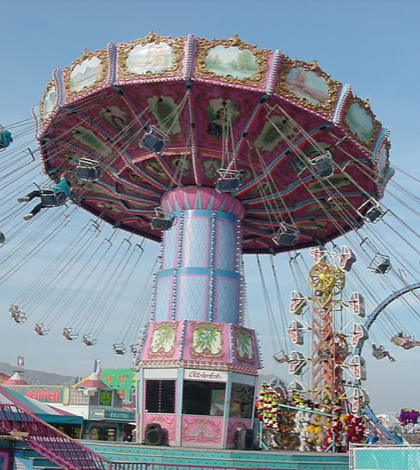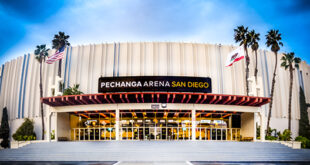Some vendors say the absence of $1 admission on opening night and an emphasis on attracting a younger crowd might be hurting attendance, but one Fairplex official says the largest crowds don’t usually show up until the last two weeks anyway, so there’s no reason to panic.
David Zach has seen better days.
Zach, the owner of ShowersPlus.com in Sierra Madre, is a vendor at the Los Angeles County Fair in Pomona. This is Zach’s twentieth year at the fair selling shower heads, so he has a sense of how attendance is likely to play out, even in the early days of the month-long event.
As the fair completed its first full week, a stretch that included Labor Day weekend, Zach admitted he didn’t like what he was seeing.
Not enough people were visiting Fairplex’s Building 6, the exhibition hall where Zach has a 200-square-foot exhibition booth. Most of those who were passing through weren’t buying anything, from him or anyone else.
Zach wasn’t alone. One vendor, a cookie salesman who spoke only if his name wasn’t used, estimated that his business could be down 40 percent compared with last year, though he held out hope that things might turn around.
Zach isn’t so sure.
“They made some changes this year,” said Zach, whose booth features a wall of shower heads that pump water into a large recycling tub, an eye-catching display that he designed and built himself. “At this point, even though it’s still early, it doesn’t seem to be working.”
“I don’t have last year’s numbers, but I know we aren’t as busy now as we were a year ago at this time.”
By far the biggest change to this year’s fair happened in June, when the California Horse Racing Board, at the request of Fairplex officials, agreed to move thoroughbred horse racing from the fair to Los Alamitos Race Course in Orange County.
Jim Henwood, the Los Angeles County Fair Association’s president and chief executive officer, argued that Los Alamitos – which recently underwent a multi-million dollar expansion – is a better facility to host horse racing than Fairplex, with its 5/8 of a mile track and outdated facilities.
Fairplex officials also did away with $1 admission on opening day, a practice designed to generate a large crowd and get people in the mood to visit the fair. Several vendors said they didn’t care, because much of the “dollar day” patrons didn’t spend money in the exhibition halls. But Zach isn’t convinced it was a good long-term move for the fair, which creates about 10,000 temporary jobs and pumps an estimated $300 million into the local economy every year.
“It did bring a lot of people in,” he said. “You can definitely tell a difference without it.”
Fairplex officials also decided to appeal to a younger demographic, with less traditional advertising – television, radio, billboards – and more advertising on the internet and social media.
One attraction on the Fairplex midway, Grinding Gears nightclub, is clearly aimed at a younger age group, but it might be succeeding at the expense of the vendors and other more traditional attractions.
“I haven’t seen any television ads, which is unusual,” said Ron Brock, who works at Southern California Burger, an outdoor stand across from Grinding Gears. “No $1 admission on opening night, and parking is $15, which I think is a little steep,” Brock said. “I can see why people are staying away.”
This is Brock’s fifth year working at the fair; he estimates that business is down about 10 percent compared to last year, although like other vendors he declined to release exact figures.
“I think not having $1 admission on opening night was a mistake,” Brock said. “It gets people motivated to come the fair. I get the feeling that people aren’t as aware of the fair this year as they usually are.”
While it’s undoubtedly popular with some vendors, and it brought in a large crowd on opening night, $1 admission is not likely to make a comeback at the fair anytime soon, said Mike Seder, the fair association’s vice president and chief financial officer.
“We aren’t going backwards on that,” Seder said. “We feel like we made the right decision. As we get closer to the end of the fair, we expect to see the crowds go up, which is what usually happens. Maybe we haven’t gotten the volume of people that we usually get, but we haven’t seen a noticeable drop in attendance either.”
Final attendance figures won’t be available until after the fair ends its one-month run Sept. 28, Seder said.
It’s also too early to say how much, if at all, the absence of horse racing will affect fair attendance this year. The 11-day meeting at Los Alamitos began Sept. 5 and will run to Sept. 21, exactly the schedule the races would have been on if they were still at Fairplex.
“We still have satellite wagering, so people can bet on a race if they want to,” Seder said. “But I don’t think it will matter. If I could do anything to help attendance I would change the weather. If the weather cooled off, that would help a lot.”
Business at the Cal Spa might have been down as much as 15 percent during the first week of this year’s fair compared with last year, said Mick Hayes, a company salesman.
“We’re a big ticket item, the second-biggest [at the fair] behind Toyota, ” Hayes said in reference to the jacuzzis, barbecue islands and granite-topped tables that filled up Cal Spa’s 5,000-square-foot display area. “So we didn’t miss $1 admission night and I don’t think we’re going to miss the horse racing. This is my third year here, and I don’t remember seeing anyone come in here with betting slips in their pockets.”
Maybe going to the fair has become too expensive for some families, Hayes said.
“Counting parking, it costs a family of four $80 to walk in the gate,” Hayes said. “That’s expensive, and that doesn’t count the cost of food once you get inside. I’ve also heard that people are having a hard time finding discount coupons, that they don’t know where to get them. Someone dropped the ball on that.”
Business during the first week of the fair this year was noticeably slower than it was last year, said Mike Buott, who is helping to run a booth directly across from Zach’s display of shower heads.
“Take a look around, it’s terrible,” said Buott, who is working his 15th fair. “People walk by but they aren’t carrying bags. That means they aren’t buying anything, and I think it’s because everything is overpriced. The price of food is outrageous. This used to be a well-run fair, but I can’t say that anymore.”
 IE Business Daily Business news for the Inland Empire.
IE Business Daily Business news for the Inland Empire.


